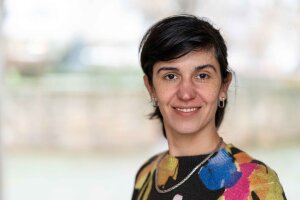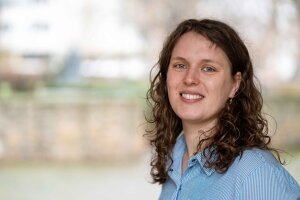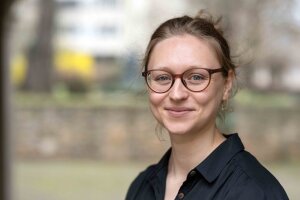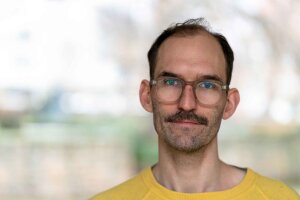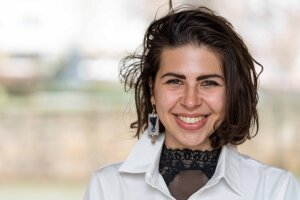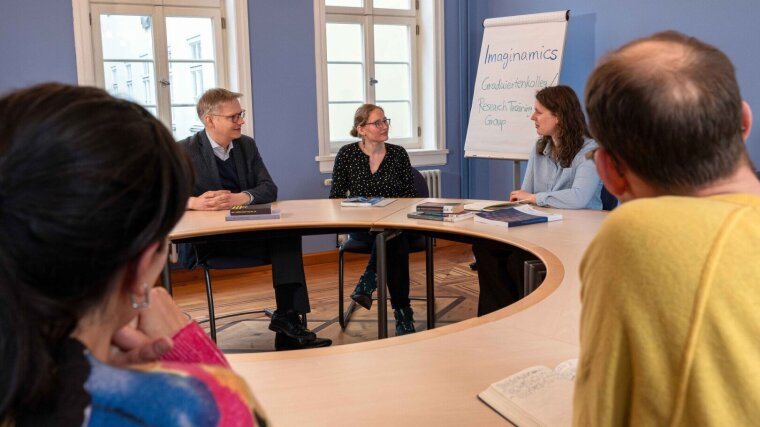
- Liberty
- Research
Published: | By: Sebastian Hollstein
University President Prof. Dr Andreas Marx opens the student congress "Imagine! Utopias and dystopias as practices of social imagining". This is also the official opening of the new Research Training Group ‘Explorations in Practices and Dynamics of Social Imagining’ at the University of Jena.
Image: Nicole Nerger/Universität JenaPeople have always created images to explain the world to themselves - not only individually, but also as a society. Shared imaginations can connect people and hold societies together, but they can also divide them or perpetuate misconceptions over time. However, little research has been conducted into exactly how this social imagination works. Friedrich Schiller University Jena now wants to change this: With the "Imaginamics" research project, it is currently applying for a Cluster of Excellence on this topic in the final round of the German Excellence Strategy competition. In order to substantiate these claims and to further establish the topic of social imagining as an interdisciplinary research area, the University of Jena has founded the new Research Training Group "Explorations in Practices and Dynamics of Social Imagining", which is being officially opened today (10 April). The Thuringian Ministry of Education, Science and Culture is funding the research training group for the next three and a half years. During this period, six doctoral candidates will be researching the impact of social imagining in various subject fields, the practices associated with it and the conditions that stimulate it. The breadth of their projects shows the importance of the research field.
Politics and literature
Aline Riedle.
Image: Nicole Nerger/Universität JenaIn her doctoral project, Aline Riedle is investigating the significance of social imagination in current political and social discourses. She is investigating how social imaginations emerge from the commitment of civil society alliances for democracy in Thuringia. On the one hand, collective practices and the everyday experiences of individual actors flow into the shared ideas. On the other hand, the involvement of concentration camp memorials and the influence of discourses on the culture of remembrance mean that current ideas are also subject to the influence of historical processes. "I want to use ethnographic methods to investigate how the respective aspects affect social imagination," declares the empirical cultural scientist. "This means that phenomena are observed where they take place through meaningful co-experience."
Carmen Pereyra.
Image: Nicole Nerger/Universität JenaCarmen Pereyra approaches the topic through literature. She analyses how authors from Latin America and Central Europe talk about crises and how they imagine the end of the world in dystopian novels. She is focussing on these two regions because they are linked by a shared colonial history. "Many works are currently being written in Latin America that analyse how colonialism has led the individual states and societies to where they are today and whether it has influenced perceptions of current and future crises," reports the Argentinian. These texts question Eurocentric notions of progress by exposing modernity as an unfinished, often violent project. Recent Latin American fantastical fiction, for example, employs narrative funds such as time loops and historical flashbacks, forcing characters and readers to confront the unresolved ghosts of colonialism. By examining these literatures, Pereyra argues that dystopian works, as cultural expressions of social imaginaries, go beyond merely reflecting contemporary anxieties. Instead, they actively participate in creating and reshaping future possibilities and have material implications for the ways in which societies perceive, prepare for, and even resist crises.
Biology and Medicine
Jenny Merker.
Image: Nicole Nerger/Universität JenaThe colonial past also plays a central role in Jenny Merker's project. She investigates how colonial knowledge practices influenced 17th and 18th century zoology and what long-term effects it had on the perception of nature. Naturalists did not classify newly discovered animal species neutrally, but within colonial knowledge systems that privileged European patterns of interpretation. Imaginative practices were not only a product of colonial structures, but actively contributed to their emergence and consolidation. They determined which animals were considered significant, how they were named and which cultural attributions they received. The doctoral student analyses how zoological descriptions were interwoven with colonial logics of order, on which sources of knowledge they were based and how collection objects - such as taxidermied or otherwise preserved specimens - were arranged in European natural history cabinets and cabinets of curiosities. She examines how these collections not only reflected colonial hierarchies, but also actively contributed to the construction of colonial claims to knowledge and power.
Azia Lafleur.
Image: Nicole Nerger/Universität JenaCollections and their presentation also play an essential role in Azia Lafleur's project - however in the field of Medicine. She explores how Medicine museums function as collective spaces where histories are told, produced and communicated, reflecting our societal notions of health, illness and disability. "Museums can remind us of how our own experiences are embedded and interwoven into a fabric of historical and cultural dimensions," she explains. "My interest centres on potential aspects of such narratives that enable the imagination of physical and mental differences and what social imaginaries this evokes." Her aim is to better understand this phenomenon and to help enable richer, more inclusive and pluralistic histories of health, illness, disability and Medicine in relation to the realities of our lives.
History and Philosophy
John Norrman.
Image: Nicole Nerger/Universität JenaImages are the very specific subject of John Norrman's research. He is investigating how caricatures visualise the ideas of crisis during the European revolutions of 1848 and 1849. "Caricatures represent the social imagination like almost no other medium," explains the Swedish historian. "You can practically observe directly how it happens as a practice. Caricaturing means observing something objectively and then transforming it into something subjective." Norrman is particularly interested in how this "trans-European mass medium" understood the revolutionary crises of the mid-19th century as a suitable time for social change and not just as a kind of social illness that needed to be cured. "I have already done a lot of work on how representations function in images - how they are used as propaganda, for example, or how they address the understanding of gender images. The new environment, the exchange with colleagues and the current research on this topic in Jena will expand my range of methods enormously," says the doctoral student, formulating his expectations of the new research training group.
Francesca Casciotta.
Image: Nicole Nerger/Universität JenaFrancesca Casciotta's work can probably also provide the hoped-for impetus. She wants to develop a kind of theoretical superstructure for social imagining. "There are currently many practical examples to describe the phenomenon and its practices, but there is often a lack of conceptual precision when it comes to theorising it," explains the Italian. "I would like to develop tools and funds for this." She considers Edmund Husserl's phenomenology to be the most promising basis for her project. This philosophical method makes it possible to analyse experiences of the social imagination, free from empirical influences, to uncover their diversity of variants and to identify the necessary conditions for possibilities. The young philosopher is convinced that she is in exactly the right place with her project in Jena. "I have already conducted research for my master's thesis here and found a very stimulating and fruitful atmosphere," she says. "There is a great freedom for discussion that I have not experienced at other universities."



